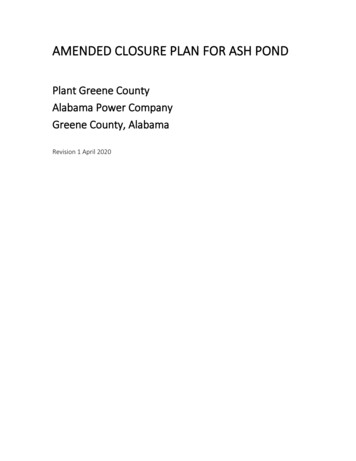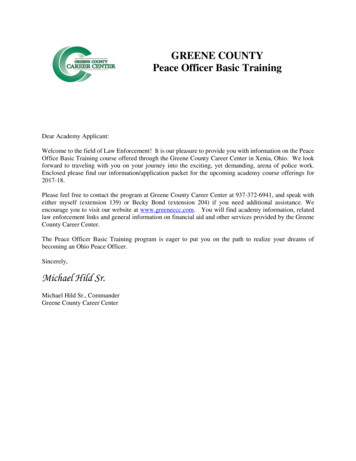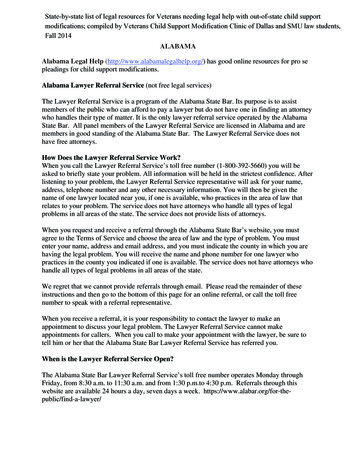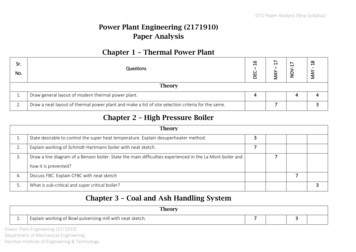
Transcription
AMENDED CLOSURE PLAN FOR ASH PONDPlant Greene CountyAlabama Power CompanyGreene County, AlabamaRevision 1 April 2020
AMENDED CLOSURE PLAN REVISION 140 C.F.R. § 257.102(b)(3) and ADEM Admin. Code r. 335-13-15-.07(3)(b)3.Contents1.Introduction . 12.General . 13.Notification – Intent to Close . 24.Written Closure Plan – § 257.102(b)(1)(i),(iii) and r. 335-13-15-.07(3)(b)1.(i),(iii) . 2a.Overview . 2b.Closure Steps . 3i.Site Preparation . 3ii.Removal of Free Water and In-situ Dewatering. 5iii.Excavation of CCR from the Closure by Removal Area . 5iv.Placement and Stabilization of the CCR within the Consolidation Area . 5v.Final Grading of Consolidation Area for Capping . 6vi.Installation of Final Cover System and Stormwater Management System . 6c.Procedures During Closure . 7i.Dewatering . 7ii.Liquids Management.10iii.CCR Removal Activities .10iv.CCR Removal Verification Protocol .11v.CCR Placement and Compaction .13vi.Fugitive Dust Control Plan .14vii.Stormwater Management .15viii.Equipment Decontamination.15ix.Site Security .15x.Groundwater Monitoring.15xi.Operational Inspections .15d.Closure Design Features .15i.Interior Dike .15ii.Barrier Wall .16iii.Final Grades .16iv.Final Cover System .16v.Stormwater Management System .16
vi.Final Site Stabilization .17e.Final Cover System.17f.Achievement of Closure Performance Standards .185.Maximum Inventory of CCR § 257.102(b)(1)(iv),(iii) and r. 335-13-15-.07(3)(b)1.(i),(iv) .206.Largest Area Requiring Final Cover – § 257.102(B)(1)(V) AND R. 335-13-15-.07(3)(B)1.(V).207. Schedule for Completing Closure Activities – § 257.102(B)(1)(Vi) AND R. 335-13-15.07(3)(B)1.(Vi) .208.Certification of Closure .209.Directional Informational Signs.2210.Vegetative Plan .2211.Site Equipment Needed.2212.Sediment Removal .2213.Erosion and Sediment Control .2214.Cost of Closure.2315.Closure Schedule .2316.Recordkeeping/Notification/Internet Requirements .2417.Written Post-Closure Plan .24ATTACHMENTSTable 1Closure ScheduleDesign Drawings
1.IntroductionThis Amended Closure Plan has been prepared to support the permit applicationpreviously submitted to the Alabama Department of Environmental Management(ADEM) for the CCR Surface Impoundment known as the Plant Greene County AshPond, located north of Demopolis, Greene County, Alabama. The permit application wassubmitted in accordance with ADEM Admin. Code r. 335-13-15-.09(1)(c). This AmendedClosure Plan, along with other documents, is intended to supplement the previoussubmittal in response to the ADEM letter dated May 24, 2019 which provided responsecomments to the original application.The closure of the ash pond will be accomplished by leaving the CCR in-place, bymethod of consolidating the existing footprint of approximately 489 acres toapproximately 221 acres. CCR removed from outside of the consolidated footprint will bedewatered, excavated, and compacted within the consolidated footprint.2.GeneralThe Plant Greene County Ash Pond was designed to receive and store coal combustionresiduals produced during the coal-fired electric generating process at Plant GreeneCounty and to serve as a low-volume wastewater treatment pond. CCR products weresluiced from the plant to the Ash Pond. The pond covers approximately 489 acres, andcurrently stores about 10,300,000 cubic yards of CCR.The Ash Pond was originally constructed between 1960 and 1965. The pond is formedby continuous dikes referenced as the east, south, north, and west dikes. The crestelevations of the dikes are as follows: the east dike ranges from 102.6-ft to 113.6-ft, thesouth dike ranges from 95.5-ft to 103-ft, the west dike ranges from 95.5-ft to 103.2-ft,and the north dike ranges from 103.3-ft to 113.6-ft. The maximum height of theembankment is 25 feet. The current dike elevations were reached on the east and westby raising the top elevations by as much as 3 feet between 1994 and 2005. Thesemodifications included raising approximately 1,500 feet of the east dike, raisingapproximately 3,200 feet of the west dike, and extending and modifying the diversiondike to direct flow westerly to allow for more travel distance to support ash deposition. In2009 the east dike was widened to the inside to address concerns with the adjoiningbarge canal slope. Finally, the west dike was widened in 2010.The outboard slope of the east dike is abutted by the slope of the barge canal. After thewidening of the east dike in 2009, the crest width from the crest of the barge canal to theinboard crest of the embankment was approximately 50 feet, resulting in anembankment that is more than twice as wide as it is high.1
The Plant Greene County Ash Pond will be closed by leaving CCR in place, withconsolidation of CCR to reduce the closure footprint to approximately 221 acres. TheAsh Pond will be dewatered sufficiently to begin removal of the free liquids and to anextent to provide a stable base for the construction of an ash containment structure forthe consolidated footprint, removal of ash outside the consolidated footprint and,construction of the final cover system. CCR will be dredged or excavated from the areaoutside the consolidated footprint, transported, and disposed of in the consolidatedfootprint to create a subgrade for the final cover system. Excavation will includeremoving all visible ash and over excavating into the subgrade soils. Additional detailsabout the dewatering and construction methods to be used can be found within thisAmended Closure Plan.The final cover will be constructed to control, minimize or eliminate, to the maximumextent feasible, post closure infiltration of liquids into the waste and potential releases ofCCR from the unit. This will be prevented by providing sufficient grades and slopes to: 1)preclude the probability of future impoundment of water, slurry, or sediment; 2) ensureslope and cover system stability; 3) minimize the need for further maintenance; and 4)be completed in the shortest amount of time consistent with recognized and generallyaccepted good engineering practices.3.Notification – Intent to CloseNotification of intent to close the Plant Greene County Ash Pond was placed in theplant’s Operating Record on April 15, 2019. The notice of intent was subsequentlysubmitted directly to ADEM. The surface impoundment is closing under the requirementsof § 257.101(a)(1) and r. 335-13-15-.07(2)(a)1. Closure of the surface impoundment willbe conducted under §257.102(d) and r. 335-13-15-.07(3)(d), closure performancestandard when leaving CCR in place. As described in more detail below, the surfaceimpoundment will be closed in a manner that will control, minimize or eliminate, to themaximum extent feasible, post-closure infiltration of liquids into the waste and releasesof CCR, leachate, or contaminated runoff to the ground or surface waters or to theatmosphere. Closure will also preclude the probability of future impoundment of water,sediment or slurry. Measures will be taken during design and construction of the closuresystem that provide for major slope stability to prevent the sloughing or movement of thefinal cover system. Closure will also minimize the need for further maintenance of theCCR unit.Major closure activities will commence following receipt of a CCR permit from ADEMpursuant to r. 335-13-15-.09.4.Written Closure Plan – § 257.102(b)(1)(i),(iii) and r. 335-13-15-.07(3)(b)1.(i),(iii)a. OverviewA written closure plan to comply with § 257.102(b) was posted to the Plant Greene CountyOperating Record on October 17, 2016. A revised written closure plan incorporatingreference to applicable ADEM Administrative Codes was submitted as a part of the originalCCR Permit application.2
As required by § 257.102(b)(3)(ii) and r. 335-13-15-.07(3)(b)3.(ii), the written closure planmust be amended whenever (i) there is a change in the operation of the CCR unit thatwould substantially affect the written closure plan or (ii) before or after closure activitieshave commenced when unanticipated events necessitate a revision of the written closureplan. The time frames for amendment to the written closure plan is in accordance withthose specified in § 257.102(b)(3)(iii) and r. 335-13-15-.07(3)(b)3.(iii).b. Closure Stepsi.1)Site PreparationAsh pond cease receipt date and activities leading up to dateThe ash pond ceased operation and receipt of CCR materials in March2016. However, after that time, the pond continued to receive low volumewastes and/or other process waters from the Plant until the notification ofintent to initiate closure was placed in the Operating Record on April 15,2019.Plant Greene County began generating electricity as a two unit coal-firedfacility in 1965. During plant operations, CCR material was sluiced intothe northern end of the ash pond and allowed to decant naturally. Thecoarser fraction of the CCR material, consisting of bottom ash, depositedin the northern portion of the ash pond, while the finer fraction, consistingof fly ash, settled out in the southern portion of the ash pond. A concreteriser structure and outlet pipe was installed at the southeast corner of theash pond, and this structure discharged water from the ash pond to theBlack Warrior River, in accordance with state regulations. Periodicallythroughout its operation, the ash pond underwent planned modifications.The exterior dikes were raised, and modifications were made at thesouthern end to direct the flow of surface water within the ash pond. Inthe mid-1990’s nine simple cycle combustion turbine units were placedinto operation for generation during peak periods.Planning to convert the plant for gas-fired operations began in 2014. TheUnit 1 coal-fired unit ended operations on February 25, 2016, followed byUnit 2 on March 30, 2016, and a project to convert both units to burnnatural gas was completed later in 2016, with the fuel supply through theexisting gas transmission pipeline installed for the combustion turbineunits. Therefore, on March 30, 2016, CCR material was no longergenerated.The design for the ash pond closure calls for consolidating the CCRmaterial within the northern portion of the existing ash pond, which willoccupy approximately 221 acres within a diked area, bounded on thenorthern end by the northern portion of the existing exterior dike, and tothe east, west, and south by a new interior dike constructed as part of theash pond closure. A barrier wall keyed into the existing underlying chalklayer will be constructed around the perimeter of the consolidated CCR3
material, along with a final cover, consisting of an engineered syntheticturf and geomembrane. The existing exterior dikes will be left in place atthe completion of ash pond closure activities. The existing dischargestructure will be removed and replaced during pond closure with areinforced concrete discharge structure and outlet pipe, equipped withstop logs to control the water level within the ash pond during and afterclosure. During this design phase, a contractor was selected and closureconstruction planning commenced.2)Contractor MobilizationThe Contractor mobilized to the site in February 2019. Initial activitiesincluded site preparation to develop contractor facilities (trailers to housesupport staff), laydown and staging areas, and initial erosion controlmeasures.3)Vegetation ManagementRemoved vegetation will be consolidated and burned in excavated burnpits using an Air Curtain Destructor (ACD). Greene County allowsvegetation to be burned year-round; however, vegetation will be removedin phases and sequenced as discussed below. Surficial vegetation will beremoved ahead of grading operations to the extent needed to supportconstruction. Existing vegetation will serve to stabilize the ash surfaceand reduce erosion.4)Clearing/GradingThe construction activities described below will be conductedsystematically in phases and repeated within each phase as closureconstruction proceeds. Initial activities within the ash pond includeinstallation of a Water Treatment Facility for ash contact water, removal ofsurface vegetation, fish and wildlife removal, construction of haul roadsusing ash material, and establishment of stormwater controls.Stormwater controls will consist of constructing ditches and installingsump areas equipped with pumps, and piping to convey collected waterto Clear Pool areas. Collected water within the Clear Pool areas will bepumped to the temporary Water Treatment Facility, and then dischargedin accordance with established permit requirements. Initial ashdewatering activities include removal of standing water (free water) withinthe ash pond, and removal of interstitial water using passive methods,such as rim ditches to reduce the moisture content and allow for CCRexcavation and handling. Passive methods will be implementedwhenever possible, and active dewatering (using wellpoint systems orother means) will be used as necessary. Removal of free and interstitialwater must take place prior to start of CCR excavation and handling andcontinue throughout the life of the project.4
5)Additional Pre-dewatering Site Specific WorkThere is no site specific pre-dewatering work for the ash pond at PlantGreene County.ii.Removal of Free Water and In-situ DewateringExisting free water is generally located at the southern portion of the ashpond. Initially, pore water and free-standing water, not utilized for dustcontrol, will be removed from the CCR and from areas within the ashpond and transferred in a controlled manner to Clear Pool areas. Waterwithin the Clear Pool will be transferred to the temporary Water TreatmentFacility for treatment prior to discharge. Initial dewatering of theexcavation areas will consist of conventional methods such as rimditching, cross ditching, sumps, stacking, and windrowing of the in-situmaterial to relieve surface and interstitial water.iii.Excavation of CCR from the Closure by Removal AreaAs initial dewatering removes interstitial water within the CCR materialand the moisture content within the CCR material decreases, the initialexcavation of CCR materials will begin.Initially, bottom ash will be excavated from the northern area of the ashpond and used to construct temporary haul roads within the pondfootprint. A Clear Pool area will be installed and pumped to assist in ponddewatering in this area.Cut and fill areas will be broken into grids, with each grid having its owndesignated equipment and manpower group with total focus on theoperations inside the work grid. Excavation and fill activities will generallyproceed from the northern portion of the pond southward. CCR materialwill be excavated and completely removed in the existing ash pond areaoutside of the new interior dike footprint (i.e., the “closure by removalarea”) using trackhoes and stacked for further dewatering.iv.Placement and Stabilization of the CCR within the ConsolidationAreaThe dewatered CCR material will be loaded into off road trucks andtransported to consolidation areas within the designated fill zones (withinthe footprint for the final cover). Dozers will spread the CCR material andmoisture conditioning will be applied as needed to achieve the desiredrange of moisture content. Equipment will compact the CCR material inhorizontal lifts to achieve the required density for the CCR material.The CCR material within the subgrade of the proposed interior dike will beover excavated and a stable, temporary slope formed to the interior toallow the dike and barrier wall to be constructed. During this time, thesubgrade beneath the new dike will be dewatered (discussed in afollowing section).5
The interior dike will be constructed using imported offsite soil borrowmaterial that meets design requirements. The soil material will bemoisture conditioned to achieve a desired moisture range and compactedin horizontal lifts to the desired elevation for the barrier wall installation.Interior dike construction will be sequenced with construction of thebarrier wall. The over excavated area along the inside perimeter of theinterior dike will be backfilled with CCR material and compacted inhorizontal lifts as the barrier wall is brought to final grade.v.Final Grading of Consolidation Area for CappingWhen areas within the closure footprint approach the designated grade,the CCR material within the final closure footprint will undergo finalgrading using precise guided equipment. At this time, a protective soillayer will be placed and compacted to protect the surface and minimizeerosion until the final cover is installed. The graded material will then besmooth roller compacted per requirements.vi.Installation of Final Cover System and Stormwater ManagementSystemAfter the final grading of CCR material and the soil cover, a final coverconsisting of a geomembrane in combination with an engineeredsynthetic turf product will be installed. This cover system meets orexceeds all requirements of § 257.102(d)(3)(i) and r. 335-13-15.07(3)(d)3.(i). The system incorporates an integrated drainage layerbetween the geomembrane and engineered turf to prevent the buildup ofwater on the cover. The final cover system is covered with amanufactured sand infill which provides further protection of the syntheticturf and geomembrane.The stormwater system for the ash mound final cover consists of anorthern perimeter channel, terrace ditch, downslope channels, andinterior dike perimeter ditch with outlet culverts. The stormwater systemfirst conveys stormwater from the ash mound final cover to the interiorarea between the interior and exterior dikes. From there, the stormwaterwill be conveyed to the discharge structure and to the Black WarriorRiver.The slope of the final cover is a nominal three percent grade, bounded bya portion of the existing exterior dike to the north, and the interior dike onthe east, west, and south. This final slope is less than the minimum 5percent slope required by r. 335-13-15-.07(3)(d)3.(i)(III). Therefore,Alabama Power will be requesting a variance on the final minimum slope.The highest elevation of the final grade (ridge line) is aligned on a northsouth axis, and a terrace ditch is located approximately halfway down theslope to collect stormwater. Downslope ditches spaced intermittentlybelow the terrace ditch convey stormwater to a perimeter ditch adjacentto the interior dike, and through culverts installed through the interior diketo the interior area to the south. The northern ditch collects stormwater6
from the northern one-third of the final cover area and also discharges tothe interior area south of closed ash area.c. Procedures During Closurei. DewateringDewatering of the CCR Ponds consists of two phases: decanting of freewater and dewatering of interstitial water within the CCR material.Dewatering will be required prior to ash excavation and throughoutconstruction.Free water collected in Clear Pools will be removed using pumps toconvey free water through temporary pipes in various areas. Theprimary area of free water dewatering is the existing South Pond area.Stormwater collected in other areas of the pond will be dewateredthroughout construction as needed. These flows will be directed to thesouth Clear Pool area, and then to the temporary Water TreatmentFacility for treatment prior to discharge to the Black Warrior River. Thedetails of the Water Treatment system are described later.Interstitial dewatering refers to the removal of subsurface water withinthe saturated CCR material. This dewatering requires lowering phreaticwater levels to improve material handling for excavation and transport.Removal of interstitial water will likely require both passive and activemethods of drainage. Interstitial dewatering could consist of acombination of the following systems: (1) open rim and cross/bleederditches with gravity drainage, (2) open pits and trenching with pumpingfrom sumps, (3) wet stacking of CCR material to allow interstitial water todrain to sumps and pumped to Clear Pool areas for removal, (4)installation of gravity toe drains, and (5) well point or deep well systems.The use of wellpoint and/or deep well systems are not currentlyanticipated but would be implemented if necessary for deeperexcavations. The toe drains will flow to a sump and then will be pumpedto the southern Clear Pool.Open dewatering and gravity drainage is a passive method that isgenerally used to dewater ash ponds. Open dewatering and gravitydrainage are generally sufficient to dewater ash ponds that containcoarser bottom ash or a mixture of bottom and fly ash and can be usedin conjunction with constructed haul roads or working platforms tofacilitate CCR excavation and hauling. For this project, gravitydewatering will mainly consist of the following key components: rimditches, settling ponds, bleeder ditches, capillary break layers, toedrains, and stacking/casting/windrowing.Excavation of rim and bleeder ditches is planned to start interstitial waterremoval. Rim ditches are excavated within the CCR material using longreach track-hoes around the perimeter of the ash pond. Bleeder ditches7
will be excavated laterally from the rim ditches using long reach trackhoes on a prescribed spacing to reduce the porewater pressure andphreatic surface within the CCR material. This will allow for massexcavation of CCR material. Excavated CCR material will be stackedparallel to the excavation, surcharging the ash below the stack, aiding indewatering and recovery in the next excavation. Depending on thewater withdrawal rates and effectiveness of the initial trenches,excavation of additional drainage ditches across the pond may benecessary. Settling ponds will be excavated in concurrence with the rimditch installation to allow the heavy solids to fall out before reaching theClear Pool.To expedite interstitial water dewatering and construction stormwatermanagement, a capillary break drainage system may also be consideredfor the ash excavation/placement around the interior dike. The drainagesystem will help relieve pore water pressure in the underlying ash as theweight of earthwork filling is applied. The drainage system would consistof coarse-graded sandy material or an equivalent free-flowing granularmaterial. This perimeter drain system would continue to function torelieve interstitial water and help collect contact stormwater until the finalimpervious cover system is installed at the end of the closureconstruction.The gravity dewatering onsite may include a toe drain system installed atthe bottom of ash excavation slopes. Toe drains allow for a more directmeans of gravity dewatering along an ash excavation slope. The typicalconstruction would consist of over excavation at the base of the slope,followed by stone and perforated piping to create a French drain system.For dewatering of wetter ash across the site, especially in the southernend of the pond, utilization of stacking & casting methods is anticipated.With this approach, ash with higher moister content will be excavatedand stacked in piles to allow for gravity drainage. A similar technique ofwindrowing may be used throughout the site. This technique involvesspreading the wet ash in thin lifts and rowing/tilling the ash to allow themoisture to evaporate from the surface.Combination of ballasted flocculation and filtration systems to treatand discharge both free and interstitial waters (site specificlimits/constraints)The temporary Water Treatment Facility is installed on the southernportion of the exterior dike, west of the existing riser structure and outletpipe, adjacent to the South Pond, and is rated for 2,000 gpm. Thetreatment system is skid mounted, and includes the following treatmentsteps:8
Water is pumped from the ash pond and treated with coagulant,polymer, bleach, and causticWater is then pumped to a mix tankFrom there the water is pumped to three ballasted flocculationclarifiersSand is added to the ballast to allow precipitation and clarificationto occurFinal solids removal using two media filters for polishingSolids are collected and dewatered and placed within theconsolidated area for disposalConstituent concentrations are monitored, and effluent water isdischarged through the permitted outfall if numerical limits set in thepermit are in compliance.Drawdown guidance regarding dike integrityIn general, the maximum drawdown rate of free water within the ash pondagainst the exterior dike is initially limited to one foot per week. Maximumallowable pumping and phreatic drawdown rates may be increased to twofeet per week if daily inspections of the existing ash pond dikeperformance indicate no adverse impacts on the integrity of the dike atthe higher drawdown rate, subject to review and approval by the Ownerand Engineer. In addition, the following criteria apply: The “per week” dewatering rate can be applied over a rolling 7-dayperiod as opposed to strictly a calendar week basis. The daily dewatering rate within this 7-day rolling period should notexceed 6 inches per day. In the event rainfall or other sources temporarily raise the free waterpool elevation during the closure construction process, an increaseddewatering rate is acceptable as long as the temporary rise can belowered back to prior levels within 7 days. This is based on thepremise that saturation of the earthen embankment will likely notoccur within this time frame.9
ii. Liquids ManagementPlant Greene County has an NPDES permit (AL0002917) which regulatesdischarges from plant operations as well as dewatering activities from theash pond closure. A temporary Water Treatment Facility that will treatwastewater throughout the dewatering process is installed on thesouthern portion of the exterior dike and is rated for 2,000 gpm. Waterwithin the pond will be managed by collecting it in sump areas andconveying it to Clear Pool locations using pumps and HDPE piping duringeach phase of the project construction. It is anticipated that pumplocations will be able to process all free water, stormwater, and drainedinterstitial waters that accumulate within work areas. Pump locat
Alabama Power Company Greene County, Alabama Revision 1 April 2020 . AMENDED CLOSURE PLAN REVISION 1 40 C.F.R. § 257.102(b)(3) and ADEM Admin. Code r. 335-13-15-.07(3)(b)3. . the east, west, and south by a new interior dike constructed as part of the ash pond closure. A barrier wall keyed into the existing underlying chalk










